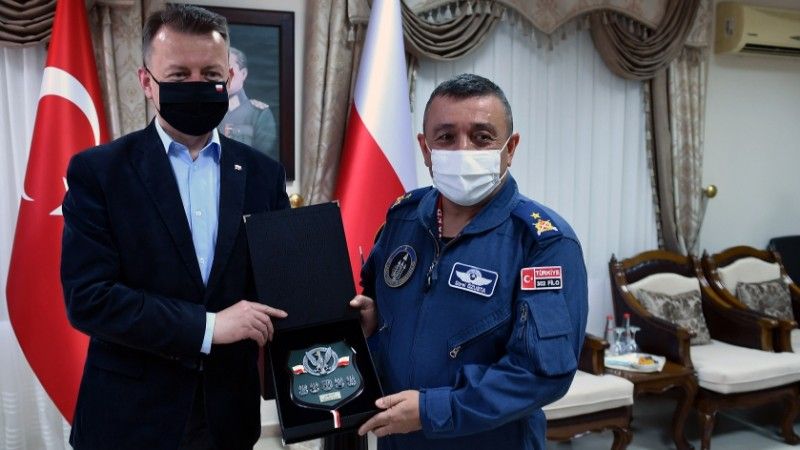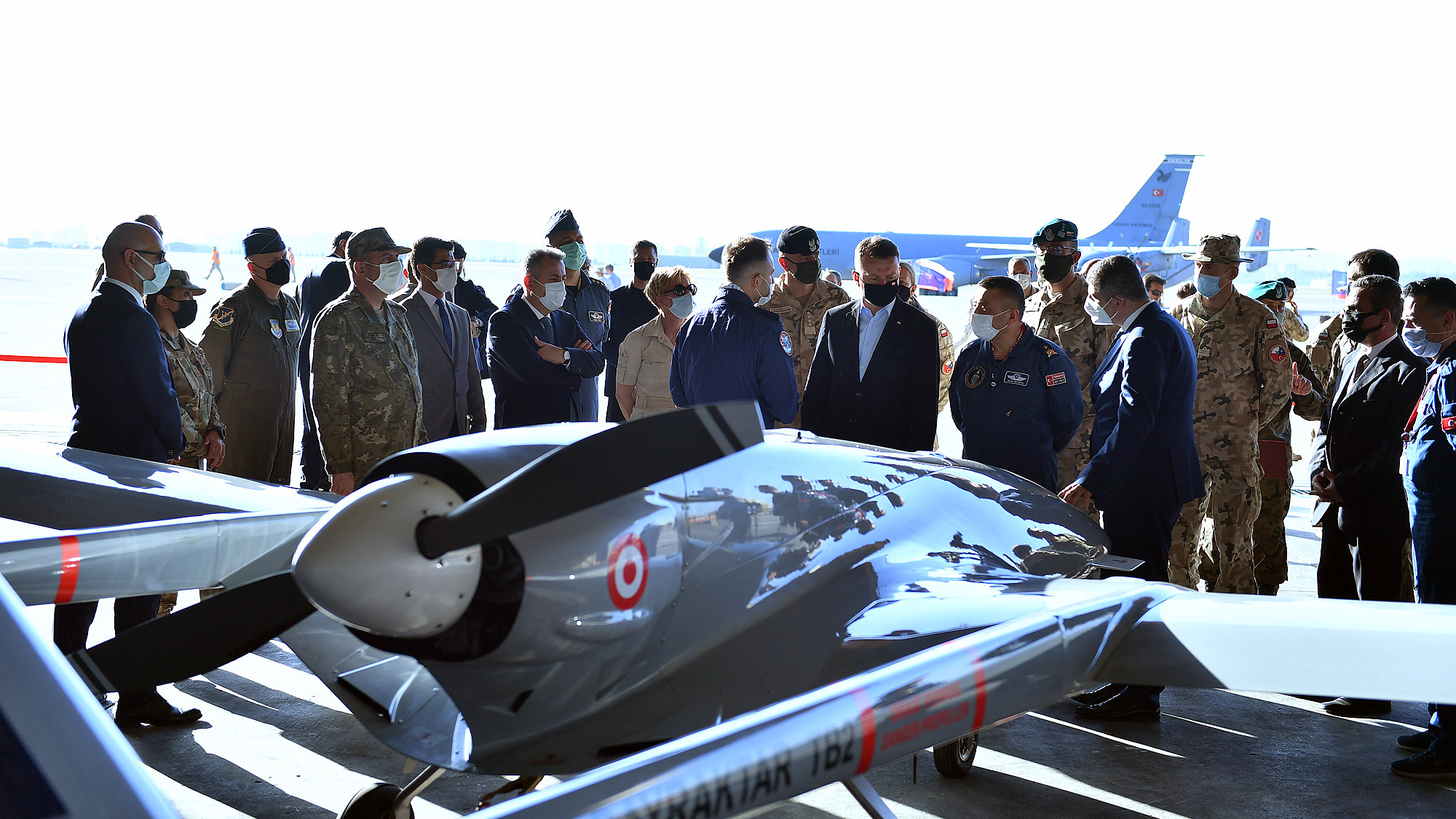Armed Forces
Turkish TB2s Alongside Gryf and Orlik. Błaszczak: We need to cooperate with the strongest NATO allies [INTERVIEW]

We are planning that the TB2s would be stationed in Mirosławiec, at the 12th Unmanned Aircraft Base. We need capabilities as such here, and now, not in a couple, or even several years - stresses Mariusz Błaszczak, head of the Polish MoD.
Jędrzej Graf: Why did the Polish MoD decide to procure the Bayraktar TB2 UAVs?
Mariusz Błaszczak, head of the Polish MoD: My aim is to continuously modernize the Polish Military, and continuously enhance our defence capabilities. Thanks to this agreement, Poland would receive equipment that has been combat-proven, very effective, and robust. 4 sets, 24 UAVs in total, would provide our Armed Forces with new deterrence capabilities, both when it comes to reconnaissance, as well as in case of the strike capacity. This is very important, as we have had no UAS of this class, that can both deliver intelligence, but also, should a need emerge, are also able to attack and destroy targets. We need capabilities as such here, and now, not in a couple, or even several years. And this is the main reason why the Turkish Bayraktar unmanned systems would be placed in the hands of the Polish soldiers as early as next year. The Polish defence industry is not offering drones of this class now, and it is my duty to provide the military with what they need to operate effectively.
There are active businesses in Poland, specializing in the manufacturing of UAVs, that successfully export their products to many countries around the world. Why the order was not assigned to them, to develop a system as such, within the framework of an R&D study for instance?
In case of any contract, order, and agreement, our first consideration is given to whether the Polish industry can deliver the given piece of equipment to the Polish troops, or what would be a potential timeline for such a delivery. This includes research and development. However, there are some situations in which the Polish Armed Forces need equipment as soon as possible. This was the case here. The Polish industry has not been offering a UAV as such “right away”.
Is the contract signed an element of the Gryf or Zefir programmes, or is it an entirely new modernization task? The Polish Ministry of Defence has referred to Bayraktar TB2 as a MALE UAV - so is it procured within the framework of the Zefir, or the Gryf programme?
We are continuously working on individual programmes. The TB2 acquisition resulted on the grounds of the current, and important needs of the Polish Armed Forces. The Polish industry has already got itself involved in the expansion of the UAV fleet. Due to the capacity they have, the Polish companies are used to deliver smaller systems - mini and micro UAVs, and loitering munitions.
What was the mode adopted for this procurement? Was it an “urgent operational requirement”? And what the scope of industrial cooperation is? Does it cover maintenance, or are capacities that can be used to develop own systems envisaged as well?
Yes, we have used the permissible procedures that used to be used in the past. This is because we really need armed UAVs of this class, and with that performance levels. The decisive factor was the readiness to rapidly and reliably deliver the product in its final configuration. The Turkish side has offered great conditions. The first UAVs would operate in the Polish skies as early as next year. The whole contract would be completed in 2024 - this is a very fast timeline. Furthermore, the Turkish side, alongside the UAV sets with ground control stations and spares supplies, would also deliver SAR radars, simulators, and a logistics and training package. Bayraktar maintenance - including the engines, ground control sensors, and cameras - would be taking place in Poland. This has been the best option, time, technology, and operational aspects considered.
In what way the TB2 UAVs would be sharing the information with systems operated by the Polish Armed Forces? Has a concept been developed, to make them a part of the C2 system? And what unit would operate those UAVs? The 12th UAV Base in Mirosławiec, or other units?
I can assure you that the unmanned platforms acquired will be compatible with the systems operated by the Polish military. This is one of the basic matters associated with the implementation of any new equipment. It needs to be able to cooperate with other elements of the system. Thus, procurement of the Bayraktar drones also includes a system for dissemination of the intel that would allow for data exchange, with the use of national and allied ICT systems. We are planning that the TB2s would be stationed in Mirosławiec, at the 12th Unmanned Aircraft Base. This is a specialized element, with experienced personnel of track-proven record. In this way, we would be using the new platforms with maximum efficiency and effectiveness, as, we should remember that alongside the equipment, the human operating it is also important.
Will the configuration of the Bayraktar TB2 UAVs be different from the standard one, that has already been used? In what way the SAR sensors will be used - instead of the optoelectronic sensor, or in parallel?
Our operators will receive systems configured in line with our, Polish, and specific requirements. We are not procuring a product that comes "straight from the production line". Our Bayraktar systems will differ from counterparts operated by other nations. Our configuration assumes that the UAVs would be fitted with: optoelectronic sensors allowing for daytime and night reconnaissance, laser rangefinders and designators, synthetic aperture radars (SAR), and laser-guided MAM-C and MAM-L weapons.
The system, as a whole, shall serve a specific operational purpose within our combat potential, hence the importance of a proper configuration. The UAVs will not be acting autonomously, but rather as an element of a bigger system. They will need to work with and complement other weapons systems. Here I am also referring to ones that will soon become a part of our inventory as well - the super-modern F-35 command center-aircraft, and the Patriot and HIMARS systems. The key is to gain an effective synergistic result, out of all of the above elements.
How would you refer to the criticism, claiming that aircraft as such may have become proven, but in theatres where no layered air defence systems were present? So - conditions were different from those that Poland may be facing, in circumstances of a threat.
The criticisms are not supported by the facts. The medium-range UAVs of this class will be one of the key elements of our defence and deterrence capabilities on the NATO eastern flank. Thanks to them we would increase the amount of information delivered to the military commanders, thus improving on something defined by the soldiers as situational awareness - so important on the contemporary battlefield. The information delivered by the Bayraktar systems will also be very valuable in designating targets for other weapons systems.

Is Poland considering also other areas, where industrial cooperation could be established with Turkey? What role is played here, by the agreement on mutual protection of information in the defence industry?
Turkey is a good ally of ours in NATO, it has a strong army and an expansive defence industry, thus cooperation between our nations is natural and mutually beneficial. The agreement, indeed, paves the way towards the expansion of collaboration and industrial relations. Only if contracts as such are beneficial for Poland, and the Polish military, we would engage in them.
A few years back Turkey has procured the S-400 air defence system from Russia, and the US consequently imposed sanctions and removed Ankara from the F-35 program. Do you think cooperation with Turkey in the area of defence and defence industry is still viable?
We are working on behalf of the Republic of Poland’s interest, hence we are looking for opportunities that would ensure the security of Poland. And this is our basic goal, which is aligned with the acquisition of the Bayraktar systems. I cannot stress it enough - Turkey is an important component of NATO. Not only because of its potential but also due to its sensitive position and military involvement. We are the NATO leader in our region, thus we need to work with the strongest, Turkey included.
NATO Summit in Brussels is scheduled to take place soon. Would Turkey be in favor of reinforcement of the Eastern Flank, in your opinion? Back in 2019, information emerged suggesting Ankara was vetoing some important arrangements.
In a political-military alliance so large, and so varied, like NATO, some discrepancies are unavoidable. This is unavoidable, and productive - in many cases. Most importantly, however, NATO is still unanimous and the alliance is working “hand-in-hand”. This is expressed through exercises and initiatives related to defence and deterrence stances, according to the 360 degrees approach. Poland is an important element here, and my goal is to increase the significance of the role we play in this relationship. As for now, I have not heard of voices that would question, in any way, the reinforcement of the NATO eastern flank. On that matter, as an alliance, we are unanimous.
Let us get back to matters related to modernization and unmanned platforms. The Gryf programme assumes that 15 unmanned systems would be procured. Do you take procurement of another system (not the TB2) into the account in this programme, with that system being potentially developed by the Polish industry, or with the involvement of the Polish industry? And is the Polish Ministry of Defence willing to take action, to stimulate the development of systems in this class by the Polish industry?
Yes. As I said, each time, we obligatorily and primarily analyze the Polish market first when procuring military equipment. This case is not different. In late 2020 we have finalized the analytical process pertaining to the acquisition of a medium-range tactical UAV, within the framework of the Gryf programme. Currently, work has been undertaken to initiate the procurement. The order shall be awarded to the Polish defence industry. I hope that this will happen, in the case of Gryf, other unmanned platforms, and any other piece of equipment.
How do you assess the Orlik UAV programme, pursued by the PGZ Group? The original schedule assumed that deliveries would begin in 2021. We know, however, that design changes have turned out to be necessary. Are delays expected, and is the rapid acquisition of TB2s related to the delays in the Orlik programme?
The acquisition of the Bayraktar systems will have no impact on the Orlik programme. These platforms are characterized by a different set of parameters, dedicated to working on different operational levels, and they would be used for different missions. When it comes to the Orlik programme, some delays are indeed expected. One should however remember that nowadays, during the pandemic, many businesses, facilities, and factories face a myriad of problems. We need to be flexible within that regard. Nonetheless, I can assure you that the Orlik deal with the PGZ Group is still in force and progress.
Do you consider acceleration or expansion of the unmanned systems acquisition, when it comes to other types? Here I am referring to the smaller FlyEye UAVs that work with the Polish artillery. Recently, a large lot has been acquired for the Territorial Defence Forces. The Army, meanwhile, still suffers from deficiencies here.
Generally speaking, we are going to develop the unmanned potential across all branches of the military. This is a good, and modern direction. In recent years we have procured almost 20 FlyEye systems, that are great in what they do for the artillery, rocket artillery, and the Territorial Defence Forces. The Polish soldiers deserve [to use - ed.] the best equipment. Before it had not been available, or they had to wait for years to get it. They have been waiting 10 years for a UAV system, such as Bayraktar, as they, themselves told me when I was visiting Turkey. Thanks to this agreement, they would be finally getting it.
Thank you for the conversation.
